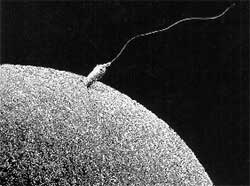Victim of changes
 all evolutionary changes are ultimately brought about through mutations. Occurring at random, mutations lead to the creation of new genes that carry the various hereditary traits. The likelihood of a certain mutation occurring has no connection with whether it is likely to benefit or harm the individual.
all evolutionary changes are ultimately brought about through mutations. Occurring at random, mutations lead to the creation of new genes that carry the various hereditary traits. The likelihood of a certain mutation occurring has no connection with whether it is likely to benefit or harm the individual.
Genes in all living organisms are present as identical copies in their cells. But when it comes to the evolutionary process, only those mutations that occur within a restricted set of cells are of any importance. These cells belong to the germ line, a lineage that eventually creates sperm and egg cells in males and females respectively. As far as the germ lineage is concerned, there is a curious possibility that more mutations occur in males than in females. J B S Haldane, the distinguished British geneticist, first proposed this hypothesis in 1947.
Haldane had argued that the time most likely for a mutation to occur would be during cell division while the cell's genes are being copied. And the greater the number of cell divisions in the ancestry of a certain cell, the higher the probability of it, or one of its cohorts, harbouring a mutation.
Now, it in females, about 33 divisions occur between the period of ferti-lisation and the formation of an egg cell, while in a male, this goes up to 205 during the fertilisation period and sperm-cell formation. Everything else being equal, males should have a mutation rate that is about six times higher than that of females.
The hypothesis was supported by indirect estimates of mutation rates in higher primates. However, a test was needed to confirm this theory. Recently, such a test was performed by H Eldgren and A K Fridolfsson of the Swedish University of Agricultural Sciences, Uppsala in Sweeden ( Nature Genetics , Vol 17, No 2).
The Swedish team confirmed Haldane's prediction by comparing rates of molecular evolution in bird genes. To be more accurate, they have estimated the relative rates at which changes caused by mutations are incorporated into the entire avian population.
Like humans, avian sex determination depends on chromosomal consti-tution. Birds carrying two copies of a z chromosome are males whereas birds with one z and one w chromosomes are females.
Human sex determination operates in a similar fashion, except that with us, two copies of the x chromosome lead to female development while two unlike sex chromosomes (one x , one y ) lead to development of the male.
There are two corresponding and therefore, comparable genes on the avian z and w chromosomes: chd-z and chd-w . The w chromosome is passed down only from a mother to the daughter and is absent in males. Eldgren and Fridolfsson compared the dna sequences of these genes in several avian species. They compared the synonymous regions of dna (these are different but coded for the same amino acid) and the intervening regions or introns which do not code for any amino acid.
The average rate of sequence change in chd-z was 2.9 (synonymous mutations) to 4.6 (intron mutations) times that in chd-w , exactly in line with what would be expected on the basis of Haldane's theory.
The fact that birds were used in this study guarantees the accuracy of the results. Mutations that occur on the avian z chromosome or on the mammalian x chromosome are checked by the process of natural selection more frequently than mutations on any other chromosome.
This is because these mutations occur in a single copy - the w and y chromosomes carry very few genes - and so they cannot be masked by the presence of a normal copy on the other member of the chromosomal pair. So deleterious mutations, forming a vast majority of all mutations, on z and x chromosomes would be weeded out rapidly, leading to a lowered mutation rate on the avian z or mammalian x chromosome. In the case of mammals, this would mean a higher rate of mutation on the y chromosome. It would then be difficult to decide whether this was because the y chromosome occurred only in males or because it occurred in the sex in which single mutations cannot be masked as in all male mammals.
However, in birds, the two possible causes operate in opposite directions - it is the female that carries an unpaired sex chromosome, not the male.
This confirms that the higher rate of mutation in chd-z is genuinely a male sex-specific effect.
Related Content
- Judgment of the Supreme Court regarding pollution caused by untreated effluents discharged by tanneries and other industries in Tamil Nadu into the Palar river, 30/01/2025
- Towards climate resilient ocean economies in Africa
- Order of the National Green Tribunal regarding welfare of the victims of LG Polymers gas leak, R R Venkatapuram village Visakhapatnam, Andhra Pradesh, 01/06/2020
- Order of the National Green Tribunal on gas leak at LG Polymers chemical plant in RR Venkatapuram village, Visakhapatnam, Andhra Pradesh, 08/05/2020
- The imperative of climate action to protect human health in Europe
- Multi-sector exposure and vulnerability to urban development and climate change in Indian megacities: case of national capital territory of Delhi, India
